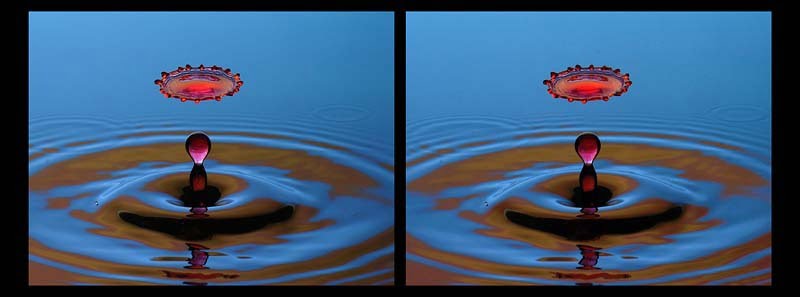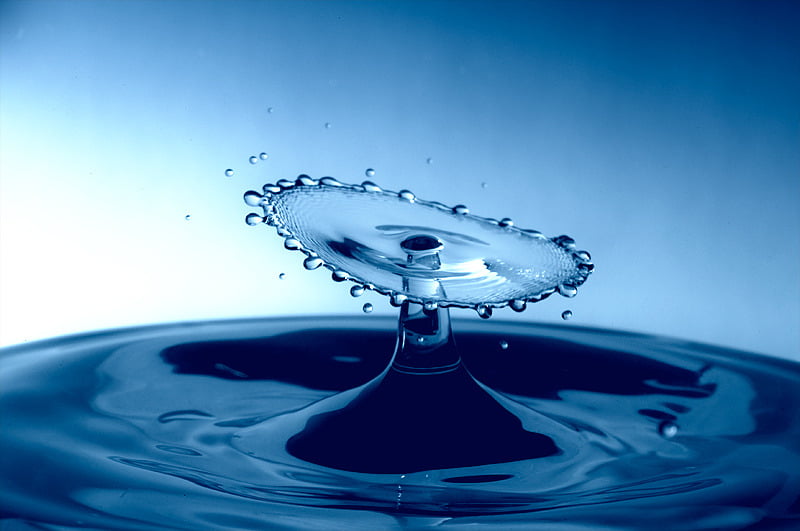When droplets collide, there are three basic outcomes: they bounce off one another; they coalesce into one big drop; or they coalesce and then separate. Which outcome we observe depends on the relative importance of the droplets’ inertia compared to their surface tension. This is expressed through the dimensionless Weber number, made up of density, velocity, droplet diameter, and surface tension. For a low Weber number droplet, surface tension is still significant, so colliding droplets bounce off one another. At a moderate Weber number, the droplets coalesce. But when the fluid inertia is too high, as in the high Weber number example, the drops will coalesce but still have too much momentum and ultimately separate. (Video credit: G. Oldenziel)
Tag: droplet collisions

Drops Through Drops
The splashes from droplets impacting jets create truly mesmerizing liquid sculptures. Corrie White is one of the masters of this type of high-speed macro photography. Her work captures the instantaneous battles between viscosity, surface tension, and inertia. The fantastic structure seen here through the falling droplets is created by a series of drops timed so that the later ones strike the Worthington jet produced by the initial drop’s impact. (Photo credit: Corrie White)

Atomizing Jets
The breakup of impinging jets into droplets (also called atomization) and the subsequent dynamics of those droplets are important in applications like jet and rocket engines where the mixing of liquid fuel with oxygen is necessary for efficient combustion. This video showcases recent efforts in high fidelity numerical simulation and modeling of such flows. The complexity of the problem requires clever ways of reducing the computational efforts required. One such method uses adaptotive meshing to concentrate grid points in areas where variables are changing quickly while leaving the grid sparse in areas of less interest. Because the flow is constantly evolving, the mesh must be able to adapt as the simulation steps forward in time. Even so, such calculations typically require supercomputers to complete. (Video credit: X. Chen et al)

High-Speed Droplet Collisions
This high-speed video shows the apparatus often used by photographers for fluid sculptures created from droplet collisions. As amazing as these formations are in still images, seeing their evolution at 5,000 fps is even more lovely.

Fluid Sculpture
Droplet collisions captured instantaneously create beautiful fluid sculptures that, though common, are too fast for the human eye. Here a bubble was blown onto the surface of the fluid, then a droplet was released to fall into the center of the bubble, bursting it. As that droplet rebounded in a Worthington jet, a second droplet was released and impacted the jet, creating the umbrella-like shape in the center. See Liquid Droplet Art for more photos. (Photo credit: Corrie White and Igor Kliakhandler) #

Stereo Liquid Sculpture
This stereo 3D photo shows the Worthington jet ejected when a droplet impacts a pool. The flat crowning drop is formed from an ejected droplet colliding with a falling droplet.

Crown Breakup
When a droplet falls into a pool of similar fluid, one often observes a crown-like impact effect. This student video shows high-speed footage of different fluids crowning and explores the effects of surface tension on crown breakup.

Rain Drops in Puddles
As those of us in Texas get drenched by Tropical Storm Hermine, it’s worth taking a moment to enjoy the beauty of each rain drop hitting a puddle.

Bouncing into a Pool
Here is another take on what happens when a drop of water falls into a larger pool.

Liquid Umbrella
Droplet collisions, usually with water or milk, are popular with photographers for their artistic value. As stunning as these still images are, high-speed video makes the effect even better.
Photo credit; See also: Liquid sculpture and Flickr




